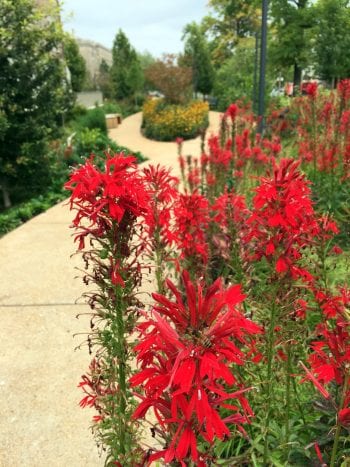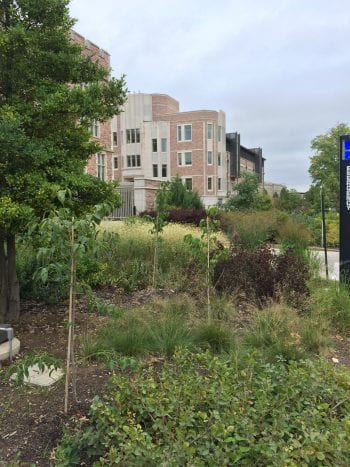Along with the crisp fall air, September brings with it a shifting landscape. By this time the school year is in full swing, but as you are bustling about campus, spare a moment to take in the landscape: all around you are thriving communities of plants.
At any given time, these plants are doing much more than providing a pleasant view for us. They were chosen for that location specifically based on their ability to thrive and on what ecosystem services they can provide, such as temperature moderation, storm water filtration and management, air purification, carbon sequestration, habitat creation, pollinator support and energy conservation.
Kent Theiling, Grounds and Landscape Design Manager and Chris Anderson, Grounds Inspector at the Danforth campus have described for us the different measures recently taken to ensure landscapes are both beautiful and ecologically performative.
Swapping Turf for Native Plants
By 2020, the Danforth campus should have at least 10% of its turf replaced with native species. Although lush and vibrant, lawn grass is often the most sterile part of any landscape. This monoculture offers little nourishment to pollinators like bees and butterflies that are vital to the health of the native ecosystem and our own food systems. In contrast, native species are better adapted to the local climate and soil, more resilient to pests and disease, require less resources and water to maintain, and constitute a good habitat for a rich biodiversity. A few recent projects that champion native landscaping can be found around Hillman Hall, along the east side of Forsyth, and along the west side of Big Bend.

Cardinal Flower
Hillman Hall Raingarden
If you take a stroll around Hillman Hall, you get a better sense of what a native, adaptive and performative landscape means. The Hillman Hall landscape is composed of 70 percent native species, one of which is in full bloom right now, the Cardinal Flower. This elegant and strikingly red flower attracts native pollinators like hummingbirds and butterflies. It is commonly found along streams and requires moist soil, which makes it a perfectly adapted plant for the rain garden on the south side of the building that is designed to collect and hold storm water.
Along the south side of the building, the sunken strip of plantings and soil acts as a catchment for water runoff around the site. This polluted water is absorbed and filtered through specially adapted plants and soils in the basin that help regulate the amount of nitrogen and phosphorous entering the ground. This bioretention basin is crucial to the prevention of street flooding and combined sewage overflows further downstream.
Walking westward through the raingardens of Hillman Hall you can see biodiversity flourishing with a wide variety of bees, birds, and butterflies pollinating and inhabiting the plants.
However, all is not paradise around Hillman. An irregularly dry summer tested the young landscape, only in its third growing season, and proved difficulty for new plantings along Forsyth. For more mature native species that are better adapted to a temperamental St. Louis summer this dry spell can be tough, but young plants need special care and attention. In the past five years, St. Louis has experienced two of its worst weather extremes with severe drought and flooding conditions that have impacted the native ecosystem. With a shifting climate, it is more important than ever to help facilitate a more resilient and stable landscape where we can do so, and that is exactly what our passionate ground services aims to do.
Beyond the Hillman landscape, a few other exciting landscape projects to look out for are the plantings along Forsyth Blvd, the Oak Allée behind Graham Chapel, and the West End Rework along Big Bend Blvd.
Forsyth Blvd Plantings

Forsyth plantings
This nearly half mile long stretch of extensive landscape features a rich variety of native plant and tree species. These plantings are hosts to pollinators, birds, and even small mammals like field mice and rabbits. This stretch of land works to absorb storm water along the pathway and provides shade and a cooler environment during warmer seasons.
The Oak Allée
The Oak Allée outside of Olin and behind Graham Chapel has been expanded to include six more trees (80 percent more). These trees will help provide shade to the walkway, sequester carbon from the air, and restore habitat after the older dying trees were taken out. These trees were planted farther apart than the previous Oak Allée trees to ensure a healthier and longer life with less competition for root and canopy space.
West End Landscape
The new bike lanes along Big Bend Blvd that stretch between Forest Park Parkway and Forsyth Blvd feature a divided path for bikers going both ways, a landscaping strip and a walkway for pedestrians. This landscape strip, along with the pervious pavement, allows water to seep into the ground instead of pooling on the pavement or in the streets. The green strip features native grass and trees that provide a beautiful and ecologically performative safety barrier between cars, bikers, and pedestrians.
The Danforth Campus is teeming with life. The next time you are on campus, take a moment to stray from your normal route to check out one of the sites mentioned above. There is much to appreciate and learn about the function of each plant in the landscape and the many processes taking place there to create a healthier ecosystem.
Article by Kristen Patino, Student Associate